Insulating your basement will not be enough to reduce the humidity; insulation controls the temperature of a room. In fact, depending on why your basement is humid, insulation can worsen humidity by increasing the air’s temperature and thus its capacity to hold moisture.
Humid basements are not just smelly and annoying, they can affect the house’s structure, including the upstairs. Below I present a variety of reasons why your basement might be humid, along with possible solutions you can implement to rectify the situation.
1. Your Yard Slopes Toward the House
Although having a sloping yard might be a unique design feature that could set your house apart from others on the block (you can even get creative with walkout or daylight basement designs), it actually has a great disadvantage when it comes to increasing humidity.
If your yard slopes toward your house, you will probably experience humidity in your basement. This is because any rainwater, or runoff, that flows into your yard will simply trickle downwards towards your home, and can collect near the basement wall.
The soil next to your house can be a catchment area for the water and can become easily saturated, with the water traveling underneath the house and into the basement.

Solutions
An easy method to combat this problem and to prevent humidity from developing in your basement is to install some sand around the perimeter of your home. Install it so that it slopes away from the house will ensure that any water moving towards your house gets stopped in its tracks.
It is recommended to install the sand at a minimum of 1″ per foot for at least half a dozen feet.
2. Improperly Positioned Gutter Downspouts
Another reason for having high levels of humidity in your basement could be that your gutter downspouts are not positioned correctly.
Gutter downspouts are vital to allow water that collects on your roof to drain from the house, and although they are not necessarily required by law, the IRC does outline various requirements for the correct dimensions and angles that your gutters should be if you decide to install them.
The IRC P2912.5 states that gutter downspouts need to be angled away from the house and towards water collection points because, if they are angled away from these points, water can run to the base of the house and can enter the walls of the basement thereby causing humidity.
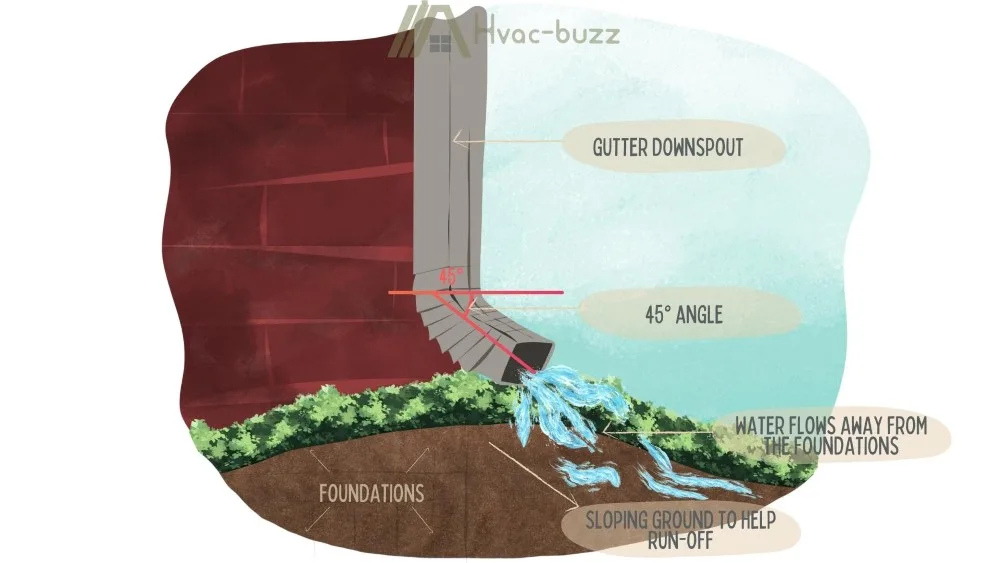
It is required that the specific angle of the downspouts should be at a slope of at least 1/8” per foot of the downspout.
Solutions
Make sure you install your gutter downspouts at the correct angle, as set out by the IRC, to avoid any pooling of water occurring outside of the collection points.
If you find that water is still reaching the foundation of your home, it is also recommended to get a gutter extender, which will angle the downspout even further away from the house. The extenders can be purely functional, like the Frost King Automatic Rollout Gutter Extender (amazon link) or they can be a magical addition to your beautiful garden, like the one pictured below.
3. Basement Installed Near Water Table
If your basement is installed near a water table, you could be at risk of having humidity issues in that room.
A water table is an area in the ground that becomes completely saturated with water. The water table can rise and fall depending on the amount of rainfall the area has or the volume of runoff water that it collects.
Having your basement by a water table makes it susceptible to hydrostatic pressure (force created by water), which can cause leaks on your basement walls and floor.
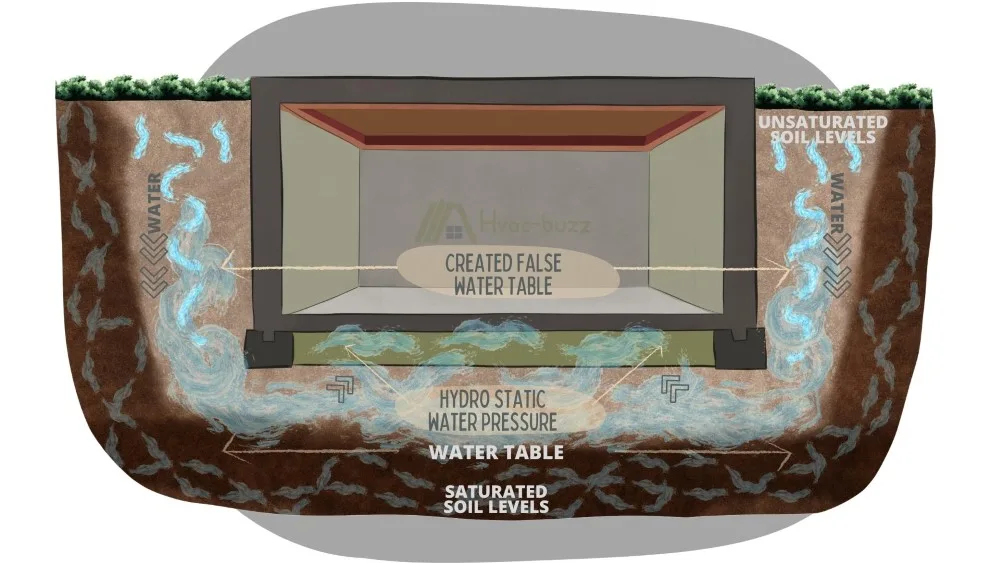
Solutions
Obviously, the best solution would be to make sure your basement is not built near a water table, but of course, this is usually unavoidable.
A more realistic solution would be to waterproof your basement walls to secure them against any leaks. A great option for this is to use Drylok Original or Drylok Extreme.
Another way to combat this situation is to install a drainage system either inside or outside the basement, which will reduce the hydrostatic pressure around the house. Consequently, less water will seep through the walls and floors.
4. Damp Is Seeping Through the Untreated Basement Floor
If your basement floor is untreated, you are at risk of normal ground moisture entering the room as there isn’t a barrier on the basement floor to prevent this.
Untreated basement floors are usually just made with concrete. The concrete contains pores, or small holes, which allow moisture to seep through by two methods: firstly, by hydrostatic pressure and secondly by capillary action (the ability of a liquid to flow through a narrow space independently).
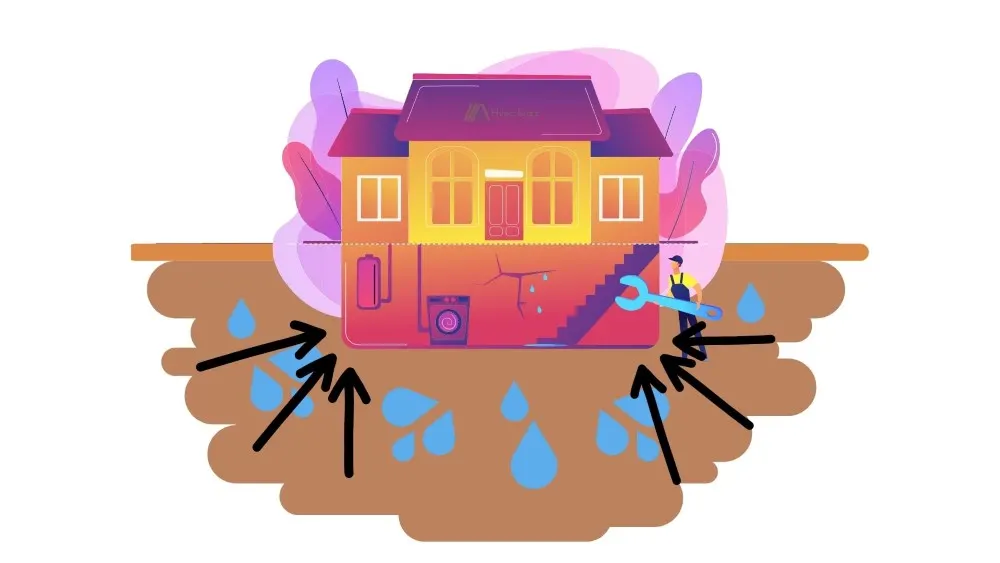
Once the moisture enters the basement, it transforms into water vapor due to evaporation. This moisture in the air will increase the room’s humidity. It has been found that an untreated basement floor can cause a dozen gallons of moisture to be transferred into the basement every day!
Solutions
In order to ensure the minimum amount of moisture is seeping through your basement floor, it should be treated with a non-porous material. Either make sure the concrete you use has a very low water to cement ratio, as this makes the material less at risk of letting moisture through, install a vapor barrier, or consider sealing your basement.
If funds are low and you are in need of a quick fix for the time being, seal any larger gaps and holes in the concrete that would allow a large amount of moisture to seep through.
Damp seeping through the walls and floor is even more of an issue and harder to deal with in a sub basement.
If you have some cracks in our basement floor that you need to fill before sealing the whole floor, why not investigate some of the more creative techniques instead of just cement.
5. You Live in a Humid or Rainy Climate
Sometimes humidity can happen for a reason completely out of your control.
Unfortunately, if you live in a climate that is known to have regular rainfall and high humidity levels, such as Florida, Louisiana, or Mississippi, your chances of having humidity in your basement are really high. This is because the air around and in your house will be quite saturated with moisture, which will end up increasing the moisture inside your home.
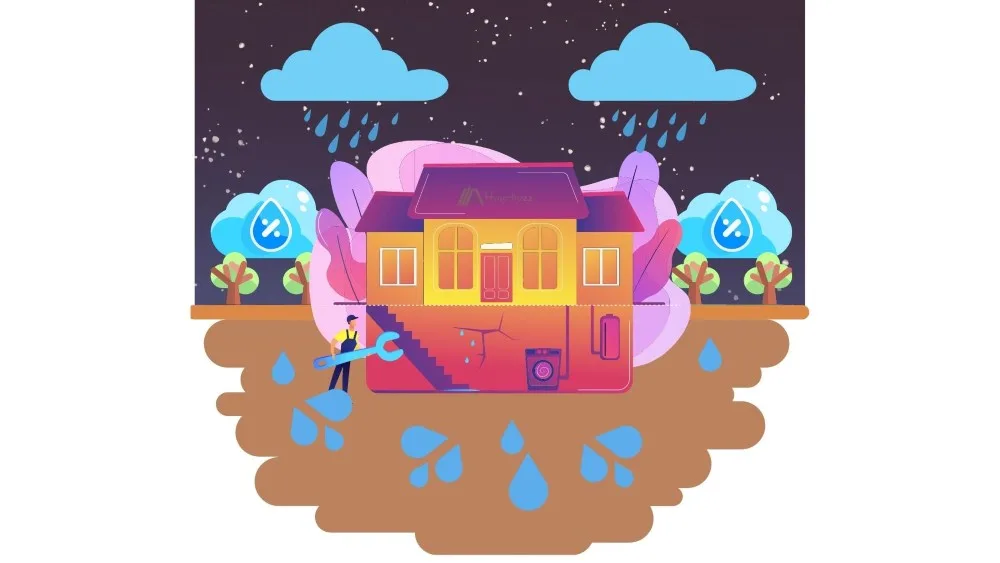
Add to that the reality of a basement being higher in humidity than the rest of the home, and you have quite a problem on your hands. You might notice the increased humidity in this room if the air feels thicker and the walls might even feel wet to the touch.
Solutions
You live in a place that’s constantly raining, or the air is always sticky with humidity. In order to prevent the damage that can be caused by humidity issues in the home, and to improve the overall comfort levels in your home, you might want to invest in a whole-house dehumidifier.
These can be portable or if you get a more advanced one, you can hook it up to your HVAC system. Although your HVAC system is also there to move the air and reduce humidity, in certain rainy climates, this job can be too much for your HVAC. Thus, the dehumidifier will be able to pick up the extra slack.
Whole-house dehumidifiers are great because, as the name suggests, they are efficient in reducing the humidity in not only your basement but throughout the rest of the house too.
6. Your Basement Has Structural Leaks
Your basement can be experiencing humidity if there is the presence of structural leaks.
Over time, cracks in your basement floor can allow for moisture to enter the basement. This moisture can come from excess water pooling around the basement foundation, which will then leak into the basement.
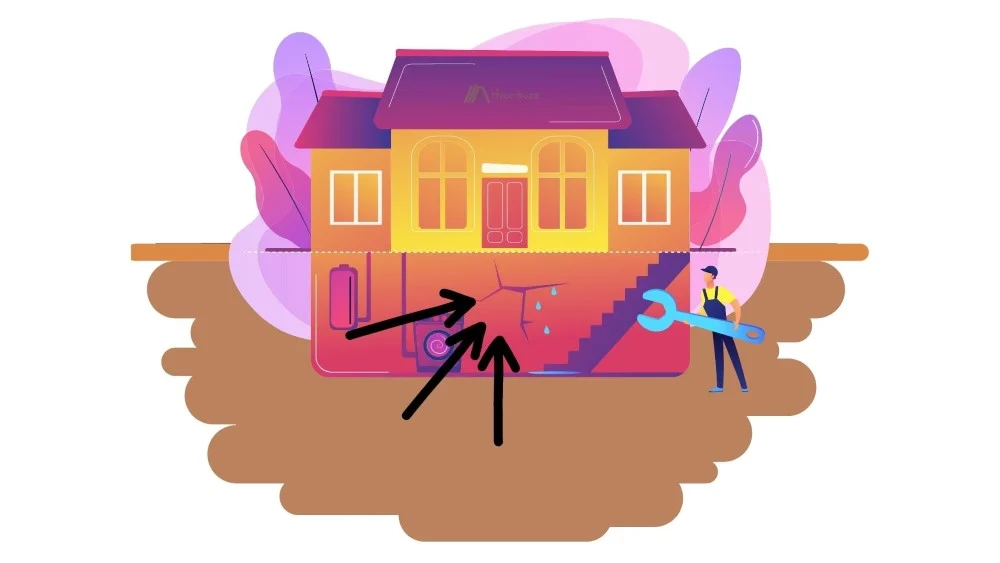
Another structural leak that can occur is when your windows have not been installed or sealed efficiently. Your windows are there not only to let in air and light but also to provide a barrier from the conditions outside. When warm air contacts the cold window, condensation can occur.
This condensation can cause water to accumulate around the windows and can create mold and mildew.
If your windows are not sealed properly, moisture can enter the basement even more easily as humidity from the outside can travel inside through the small cracks around the windows.
Solutions
Regular maintenance and repairing of cracks as soon as they appear can help to reduce this source of humidity in the basement.
You could also install double-paned or glazed windows in your basements to reduce the amount of condensation that will form on the glass. This method will also reduce the amount of air that can travel through the small holes in the windows.
A cheaper method, but probably not as effective, would be to install thick curtains over the windows to reduce the amount of air that can come in contact with the glass, and limit the condensation that forms.
Sealing your basement floors is also vital if you want to prevent moisture from entering the basement through any pores or cracks.
7. Your Pipes Are Leaking
Simple wear and tear, and other more serious issues, can sometimes cause your pipes to start to drip water. This water can accumulate and cause humidity in your walls and ceiling. Unfortunately, once you start to notice the after-effects of a dripping pipe, you may have a lot of damage on your hands.
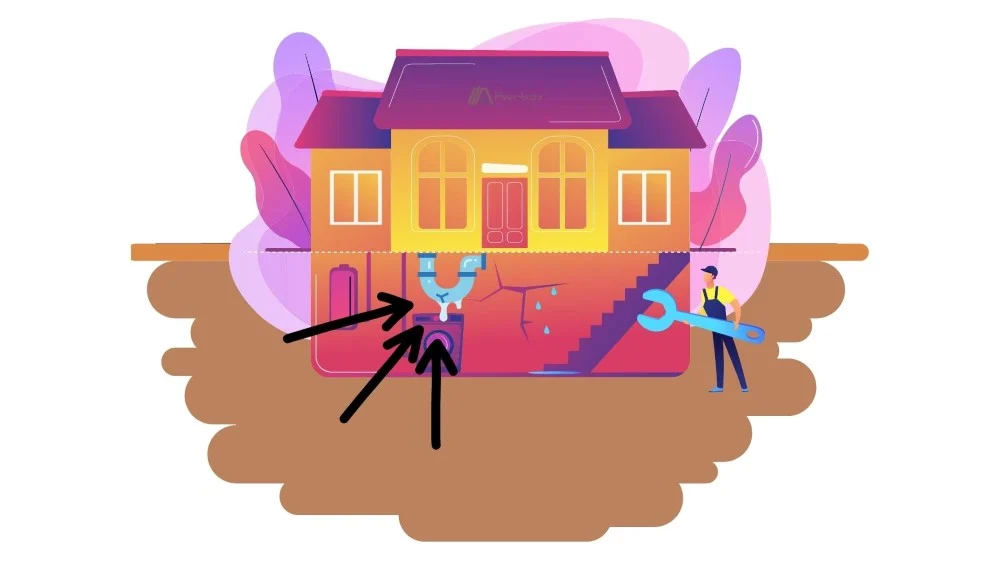
Solutions
It is best to regularly inspect your pipes for any signs of rotting, moisture, or corrosion. This way, you are able to catch the damage and repair or replace them before extensive damage is done.
Once you have discovered a leaky pipe, you can rectify the situation in couple of ways. First, you can simply seal the pipe at the weak points where the water is coming through. You can use epoxy over the affected area to do this.
If your leaking pipe has turned into a ruptured pipe, then a little more damage control is required. The broken pipe will need to be smoothed out to remove any sharp and uneven ridges. Once this is done, apply a repair clamp tightly until the leak is completely sealed.
Another solution is to fix the leak with tape that usually comes in your standard pipe repair kit. It is important to note that this can only be done for small leaks and is a temporary fix as the tape will not be able to withstand a lot of water for an extended period of time.
As a temporary fix or if your basement is prone to flooding and preventing such flooding is nigh on impossible, you can keep moisture levels down through the installation of a sump pump and system such as the Watchdog Alarm system.
8. Your HVAC System Is Not Functioning Properly
An HVAC system is truly a vital way to control the moisture content and air temperature of the air inside your home. If it functions correctly, you can have peace of mind that the system is expelling moist air outside, and you can live comfortably in your home.
However, if it is not functioning correctly, such as it is expelling the moist, exhausted air down into the basement instead of taking it outside where it should, then you can expect increased humidity in the basement. The air is not being removed from the basement correctly, so the moisture will collect there and cause an increase in the relative humidity in the room.
If your AC is expelling the hot air, which can be caused by accumulated debris and dust in the vents or a malfunctioning thermostat, then the temperature of the room will increase, which will allow for more humidity to saturate the air.
Your AC might also not be draining the cold water caused by condensation during the air cooling process properly. This can be caused by a broken discharge pump or the drainage pipes could be clogged. The condensation can increase the humidity in the house.
Solutions
It is best to invest in a good quality HVAC system and get it installed by an experienced professional. Additionally, it is essential to regularly maintain and clean your HVAC so that it continues to work efficiently. This will reduce the risk of the issue arising due to malfunctioning errors or clogged vents.
9. Little to No Effective Basement Ventilation
Since most basements usually only have very small windows (if they have any windows), poor ventilation is a common characteristic of them. In order for a room to be properly ventilated, fresh air needs to enter a space while ‘stale’ air needs to be able to leave a room.
If a basement is getting fresh air, but not expelling any old, dirty air then it is not being efficiently ventilated. The excess moisture that is not being expelled can easily cause humidity and dampness in the room.
Solutions
The good news is that there are a variety of methods to ventilate your basement, especially if you don’t have windows.
One of the best solutions to the poor ventilation problem would be to install an exhaust fan in your basement, with a vent that is connected directly to the outside. Any moisture will leave the room through this vent.
A simple and extremely cost-effective way to add ventilation to your basement is to just keep the basement door open. Any moisture in the room will be able to circulate outside the basement and into the rest of the house, decreasing the humidity in the air in the basement.
If you need to keep your basement door closed or just prefer to keep the basement private, installing a vent into the bottom of the door can assist with ventilation too.
10. Moisture/Heat-Producing Machines in Basement
More often than not, basements are generally used as a large laundry room. It’s a great way to keep your dirty clothes and a large pile of unfolded laundry kept neatly away from guests, and the endless storage space means you can keep your detergents and other cleaning products there too.
Despite its functionality, having a dryer and washer in your basement is not always beneficial. The heat that exudes from the machinery increases the temperature of the air around it. Since hot air can hold a lot more moisture than cold air, any moisture that enters the room will be captured in the air.
This will increase the overall humidity in the room which brings about a lot of risks and issues.
Solutions
Sometimes your washer and dryer exude heat during their day-to-day operations. However, if it becomes increasingly hot in the air around these machines you might want to get a professional to come and inspect them. There could simply be a clogged vent that needs to be cleared.
A simple method of cooling down the air in your basement would also be to have a portable fan running while you do your laundry. The air will then be circulated throughout the room, and if you keep your basement windows or door open, the air can leave the basement.
A dehumidifier is also a great way to remove the excess moisture from the room.
If you are able to move your laundry room upstairs, then this is also an effective solution. There are also benefits to making this change beyond just reducing basement heat and humidity.
11. Your Sump Pump is Not Operating Efficiently
A sump pump is a mechanism that transports any moisture or water from your basement to the outside of your house. It is found underneath the foundation, in a ‘pit’ of sorts, and has a special sensor that detects when water pressure or levels become too high.
Once high water levels are detected, the pump will discharge the water from your basement into a specific drainage area.
Sometimes, your sump pump might not work as well as it should. This could be due to machinery or installation errors, or simple wear and tear that comes along with age. Having periods of heavy rainfall or even power outages can also affect how well your pump operates.
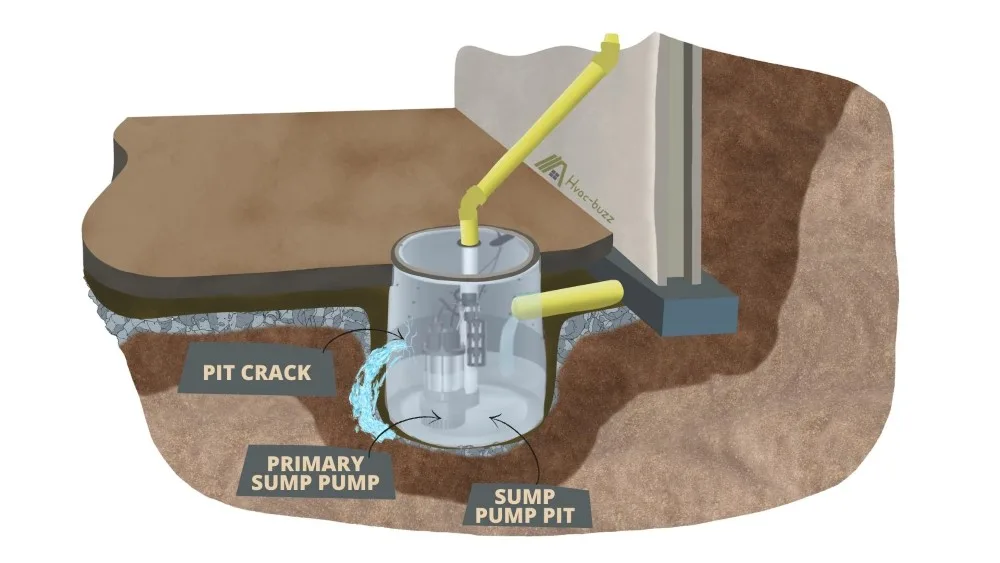
If this happens, some or all water from your basement will not be drained from the sump to the outside of the house. This means that you are at a higher risk of having humidity in your basement as there will be excess moisture.
Solutions
It is in your best interest to have a professional install a high-quality sump pump for you. These tend to last longer as there will be limited installer error, which can sometimes cause faults.
Installing a backup battery will also ensure your pump continues to run smoothly even during power outages.
If you know that your area is prone to heavy rainfalls or you know your home expels a lot of water, it will probably be wise to have multiple sump pumps installed in different areas of your basement so that your pump does not become overwhelmed.
Can a Damp Basement Affect Upstairs (Act before it’s too late)

Basement damp can spread through the walls and ceilings into the upstairs. Damp breeds mold, further compromising the structure and posing health risks. Mold can move upstairs. Damp basements make houses cold.
Damp Spreads Through Walls and Ceilings
There are outdoor as well as indoor moisture sources that are responsible for your damp basement. Moisture accumulated from appliances like dryers, humidifiers, coolers, rain or groundwater seeping inside through the cracks, and humidity from ventilation are the primary reasons why there is moisture in your basement.
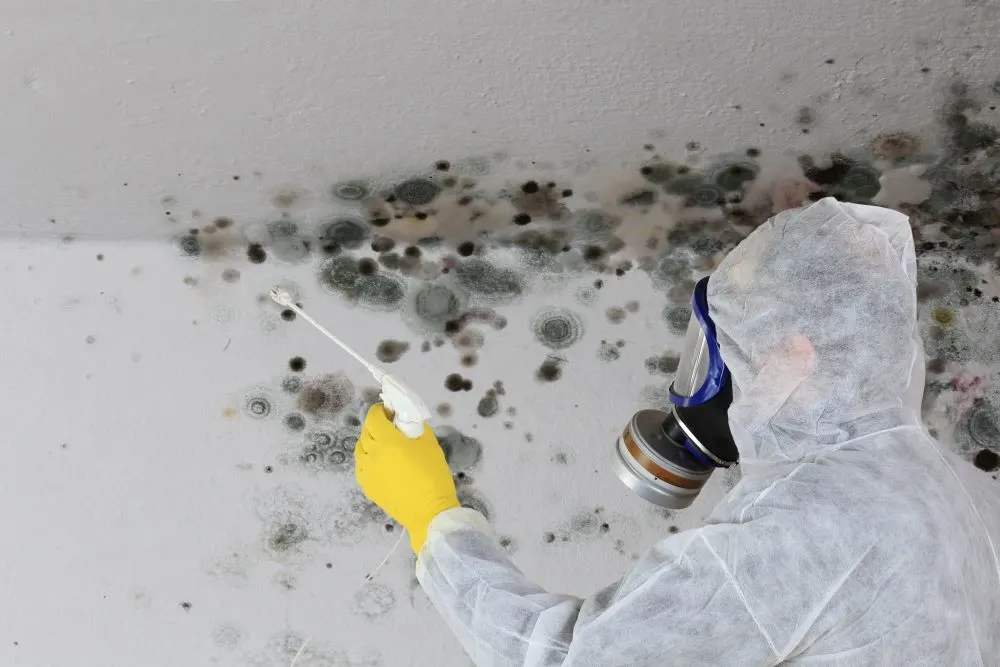
Wooden frames in your basement walls, drywalls, ceiling boards, etc., absorb moisture and make your basement structure damp.
You can opt for wooden frames made with pressure-treated wood, particularly for the bottom plate, which are resistant to rotting or moisture-resistant drywalls that reduce the chances of basement moisture and associated problems like mold, mildew, etc.
Even stone and masonry that has not been waterproofed can absorb moisture and cause structural damage to your property. Water seeps into the stone and masonry, making the brick more porous and causing moisture to travel from your basement to the rest of your house.
Moisture from the basement can creep through the walls and ceilings (particularly if the source of the damp is not promptly addressed), climbing higher and finally reaching the upstairs structures. A damp basement is capa
Damp Breeds Mold
Mold thrives in places that are damp, dark, and wet like a damp basement. One of the worst consequences of a damp basement is the breeding of mold. Once a part of your house gets affected, then chances are there that mold spores have already spread around your home.
Mold spores float in air, entering your home through vents, windows, and air conditioning systems. Once they enter, they settle on wet surfaces and then spread all over your beautiful home.
Mold needs water to grow and spread. If your basement is damp due to leakage or any other reason, then mold infestation is bound to happen sooner or later. The thing about mold is, you can smell it when it starts spreading in your damp basement.
Apart from damaging your house, mold infestation is capable of causing some serious health hazards (more on this later).
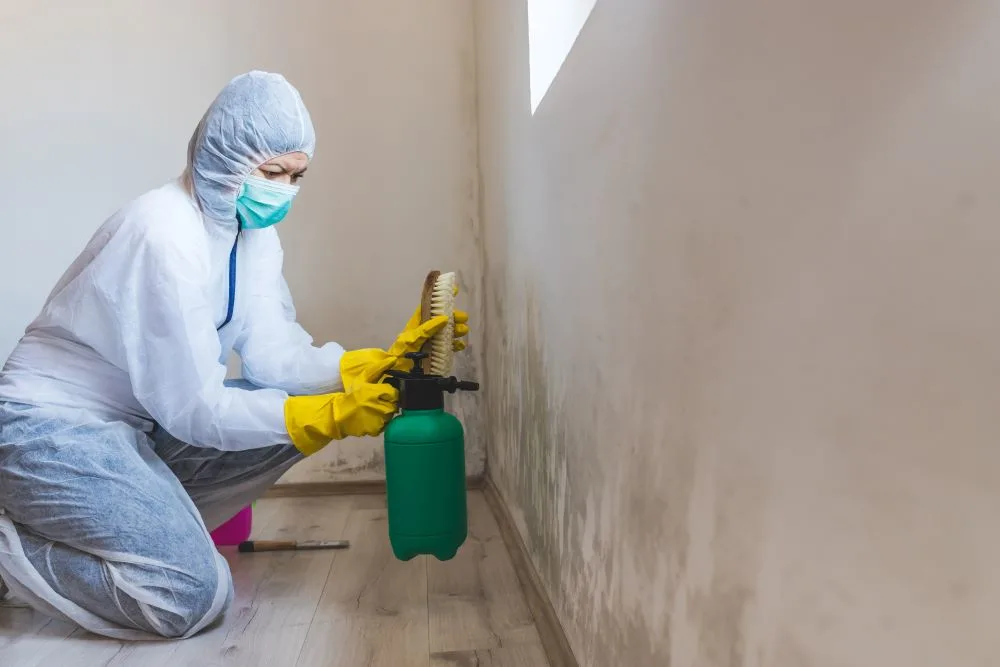
Mold Can Travel Upstairs
The natural or HVAC-generated air movements through your home cause mold from your damp basement to travel upstairs and find new breeding grounds. These spores are airborne and spread with the moist air released from the basement. Sometimes, you can even carry molds on your feet or your shoes and transfer them upstairs.
Basements are that part of the home that is seldom cleaned and is packed with unnecessary things. Hence, mold infestation often goes unchecked and untreated for a long period. Over time, mold contaminates areas near the breeding spot.
If there’s mold on the wall, then there are chances that it will spread to the ceiling, door, door frame, and more. Mold spores latch on things that are damp and start to breed there.
Appliances with air ducts like air conditioning and heater draw in mold spores. Eventually, mold starts growing in the air ducts and reaches upstairs. Mold is an indoor air pollutant and can cause several long-term and short-term health hazards. It commonly causes respiratory problems and affects the residents as well as animals living in that house.
Health Risks of Mold
You know you have a mold infestation problem by two things. First, the earthy, musty smell that’s hanging in the air, and second, when your family members start showing symptoms like regular sneezing, eye irritation, and coughing.
Mold is known to be a health risk. It causes health problems especially related to the respiratory system. If you are exposed to mold spores, then chances are, you will develop certain allergy-like reactions like skin rash, headache, coughing, sore throat, and runny nose.
As per the Institute of Medicine (IOM), when healthy people come in direct contact with the mold, they develop upper respiratory tract symptoms. It also triggers asthma symptoms, like difficulty in breathing in people with asthma, and can lead to an asthma attack.
People with existing health conditions like asthma, lung disease, chronic obstructive pulmonary disorder (COPD), and allergies are more at risk of getting adversely affected by mold.
Mold is also harmful to your pets. Dogs and cats often come in direct contact with mold spores as they tend to lick surfaces and chew on things. Mold poisoning can cause serious allergic reactions, respiratory problems, gastric symptoms like loss of appetite, vomiting, fur loss, sores, excessive scratching or licking, and many other problems.
You must take mold infestation seriously and get rid of it at the earliest for the safety of everyone you love and care about. And permanently dealing with mold infestations starts with clearing up damp in your basement.
Upstairs Can Become a New Breeding Ground
Molds are always looking for new breeding grounds. When they travel from your damp basement to the upstairs, they find new places to grow. As mentioned earlier, any place that’s dark, damp, and dingy is where they are likely to settle down.
Once mold spores reach upstairs they find new breeding grounds. A leaky roof or window, water-damaged shower pipes, surfaces with layers of dust, cracked tiles where moisture has accumulated, rotten wooden frames, on or under carpets and floor mats, and filing cabinets.
Molds also grow in home appliances that tend to preserve moisture, like washing machines, dishwashers, and air conditioners. The list of places is endless. Mold will take up residence in any place which is dark, moist, and warm.
You spend lots of time, energy, and money on making your home aesthetically appealing. Now, once mold enters your home, the beauty of your space will be compromised. Peeling of paints, cracks on walls or ceilings, warping, rotting of frames, joists and columns, stained wall—there are countless ways for mold to ruin your beautiful home.
Mold spores penetrate porous surfaces like drywall and insulation and weaken the structure of your building. Wood gets most affected because molds can feed as well as grow on wood. Molds cause damages that require costly repairs.
Cold Is Heightened by Moisture
Every time you open the basement door, a gush of cold wind rushes to welcome you (or hit you in the face, depending on the season!). Even walkout basements, which seem more like regular spaces, are often colder than the rest of the home.
Moisture and humidity will make your basement colder than the rest of your home. The moisture in the air makes the warm air rise up and the cold air settle down, resulting in low temperature.
A damp basement can make your home colder than the normal temperature. So, whenever you open the basement door, warm air gets pulled down from upstairs (temperature gradient), making the upstairs colder in winter. To keep up with this, your heaters will also be working overtime.
Moisture Compromises Insulation
When it comes to insulation and unfinished basements, the International Residential Code says that the basement must be insulated, or the rest of the house must be insulated against the unconditioned space.
If your house was insulated against the basement, then moisture from the basement may be able to get into this insulation, compromising its function. This not only makes the house non-code-compliant, but
Sources
https://extension.umn.edu/moisture-and-mold-indoors/moisture-basements-causes-and-solutions
https://www.freshwatersystems.com/blogs/blog/what-is-a-sump-pump-and-how-does-it-work
https://www.homeenergyhero.com/energy-tips/comfortable-humidity-level-in-the-basement/
https://basements911.com/blog/effects-high-water-tables-basements/
https://www.radonseal.com/radonseal-mitigation.htm
https://www.sylvane.com/whole-house-dehumidifiers.html
https://plumbinginformer.com/fix-pipe-leaking-in-basement/
https://www.turbovent.co.za/blog/11-common-air-conditioning-problems-and-how-to-fix-them/


